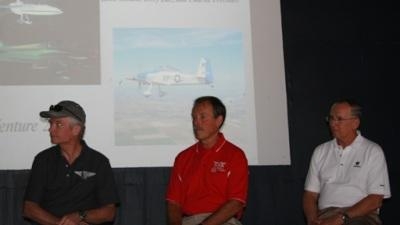Sat, Jul 28, 2012
Astronauts, Airbus Test Pilot Give Advice On How To Test Fly Your Airplane
By Bruce Brandon
One of the great things about Airventure is the camaraderie and the sharing of information and advice on aviation. We are fortunate to have some of the highest trained and most experience aviators, mechanics and engineers in the world who happily share their knowledge for the benefit of all.

On Tuesday three of the most experienced aviators in the world shared their knowledge and experience to a large audience at Airventure. Astronauts Charlie Precourt and Hoot Gibson and Airbus test pilot Terry Lutz shared information on how they test flew their own aircraft they built or made major (design of new wing and installation) modifications to. We should all listen. In addition to having the enviable experiences of flying in space or helping design and build the world’s largest aircraft, they all attended military test pilot school. When they talk, we should listen.
Knowledge is power but when test flying your experimental-home built airplane it is literally vital. A just released NTSB safety study found that “Experimental amateur-built (E-AB) aircraft represent nearly 10 percent of the U.S. general aviation fleet, but these aircraft accounted for approximately 15 percent of the total—and 21 percent of the fatal—U.S. general aviation (GA) accidents in 2011…. Ten of the 224 E-AB aircraft accidents during calendar year 2011 occurred during the first flight of the aircraft… .” the leading cause of accidents in Phase 1 testing was engine failure followed closely by loss of control in flight. “There were a greater number of accidents occurring during the first flight by the new owner of a used E-AB aircraft compared with the first flight of a newly built aircraft”. E-AB aircraft are crashing at the rate of approximately two every three days.
What can the new E-AB builder/owner do to not become a statistic?
- Have a plan. Talk with others who have conducted flight test. Benefit from their advice.
- Keep yourself under control as well as your airplane. Don’t see “what she will” do on the first flight. Proceed in a slow paced and methodical test flight regimen.
- Fly an airplane like the one you have built/purchased with an instructor to get the feel of the airplane and learn from your fellow pilot(s).
- Consider having a chase plane to be sure that your airspeed indicator is accurate. Make sure the pilot in the chase plane knows what he/she is doing and conduct a thorough briefing.
- Use the tools that are available to you. The EAA web site has valuable information as does the FAA web site. Use them.
- AC-90-109 Airmen Transition to Experimental or Unfamiliar Airplanes. Use it.
Other suggestions include:
- If you conduct high speed taxi test, do so in incremental increases in speed.
- Conduct your flight test at altitude. This will allow you time to recover from unexpected encounters and provide time to find a landing area if necessary. (Remember, altitude is life).
- Be sure to keep a sharp eye on your engine instruments. (Remember, engine failure is the largest cause of accidents).
- Don’t stall your airplane on the first flight.
- Stay within the center of the flight envelope at first. Get to know your airplane before “pushing the limits”.
- If your gear doesn’t come up on the first attempt, leave it down and land.
- Always have a place to land should it turn into a really bad flight.
- An additional source is AC- 90-89A Amateur-Built Aircraft And Ultralight Flight Testing Handbook, Use it.
There is an effort underway to have interaction between the Society of Experimental Test Pilots and home builders. Hopefully this will occur. The initial flight in your airplane is a test flight and you are a test pilot. You want minimize as much risk as possible. Use the resources available. Have a well planned, disciplined test flight regime. Listening and learning before you fly is critical. Prepare. If it only saves your life once it is worth it.
(Pictured L-R Precourt, Gibson, Lutz)
More News
Maximum Authorized Altitude A published altitude representing the maximum usable altitude or flight level for an airspace structure or route segment. It is the highest altitude on >[...]
Aero Linx: Soaring Safety Foundation (SSF) The Soaring Safety Foundation (SSF) is the Training and Safety arm of the Soaring Society of America (SSA). Our mission is to provide ins>[...]
From 2013 (YouTube Version): Dracula Lives On Through Kyle Franklin... and We're NOT Scared! ANN CEO and Editor-in-Chief, Jim Campbell speaks with Aerobatic and airshow master, Kyl>[...]
“For Montaer Aircraft it is a very prudent move to incorporate such reliable institution as Ocala Aviation, with the background of decades in training experience and aviation>[...]
Also: ForeFlight Upgrades, Cicare USA, Vittorazi Engines, EarthX We have a number of late-breaking news highlights from the 2024 Innovation Preview... which was PACKED with real ne>[...]
 ANN's Daily Aero-Term (04.14.24): Maximum Authorized Altitude
ANN's Daily Aero-Term (04.14.24): Maximum Authorized Altitude ANN's Daily Aero-Linx (04.14.24)
ANN's Daily Aero-Linx (04.14.24) Classic Aero-TV: 'We're Surviving'-- Kyle Franklin Describes Airshow Life 2013
Classic Aero-TV: 'We're Surviving'-- Kyle Franklin Describes Airshow Life 2013 Aero-News: Quote of the Day (04.14.24)
Aero-News: Quote of the Day (04.14.24) Airborne 04.09.24: SnF24!, Piper-DeltaHawk!, Fisher Update, Junkers
Airborne 04.09.24: SnF24!, Piper-DeltaHawk!, Fisher Update, Junkers



